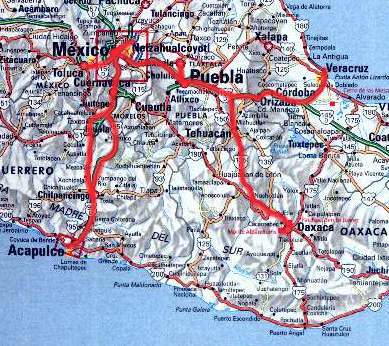 |
Mexico
|
||||||
Destinations:Mexico City I Puebla I
The reason
why we went to Mexico this year was an invitation to the wedding of our
good friends Aida from Mexico and Didier from France. But of course we
wanted to take the opportunity to see a bit of the country as well, so
we went for two weeks all together. Our trip consisted of two parts: For
the first week a bus had been hired and we toured the region with an international
group: Aida, Didier and his family, their friends Myriam and Christian
from France, Claudia and Kai from Germany and Jill and Steve from the US.
During the second week Volker and I explored some more places on our own,
travelling by public transport.
We all arrived in Mexico
City on the same KLM flight from Amsterdam around 6 p.m. local time, except
Jill and Steve from Chicago, who had arrived earlier. The view over Mexico
City from the airplane was fantastic: the huge city, the skyscrapers in
the center and the nearby mountains. It was early evening and the first
lights had come on. It looked beautiful. We were met at the airport by
Aida's parents. The bus was already waiting for us and we were driven to Puebla
which took a couple of hours. We finally arrived there after a long day
at 6 a.m. Central European Time! We checked into the Hotel Alameda (400
pesos), a beautiful colonial building, but we had a sleepless night as
it was pretty cold and noisy. Our room faced the street and the windows
didn't close properly. Well, at least we had earplugs! I didn't expect
it too be so cold in Mexico at night. With only 5°C we were freezing
when we came on the bus! But evidently there was a cold spell when we arrived
and after a few days it got a bit warmer again. And it was much warmer
down at the coast than up in the mountains.
On
Sunday morning we were invited for breakfast by Aida's mother. We had the
typical "tamales", fruit, hot chocolate and "dead bread", usually served
on All Saints' Day, November 1st. In the afternoon the bus took us to the
nearby town of Cholula. The pyramid there is
Mexico's largest pyramidal structure. From a distance it appears to be
a large hill with a colonial church at its summit. The still active volcano
Popocatepetl can be seen in the distance. The tunnels in the pyramid's
interior can be visited, which we did. Afterwards we went to see the church
of On Monday morning we
left Puebla at 9 a.m. for the Caribbean coast. We crossed the foggy mountains
and after three hours we arrived in Veracruz,
Mexico's largest port and oldest Spanish city, founded 1519 by Hernán
Cortés as La Villa Rica de la Vera Cruz. We had 28°C and it
didn't even cool down much in the evening. We checked into the Hostál
de Cortés (530 pesos), 4 stars, with pool, at the beach boulevard
south of the Veracruz
Aquarium. We had a Mexican lunch at the "Café La Parroquia"
at the Malecón with a view of the harbor. Afterwards we visited
the aquarium where marine species from the Gulf of Mexico can be observed,
including sharks and manatees. In the evening we went to the Zócalo
for a drink. Veracruz is famous for its music (Remember the song "La Bamba"?)
and its Caribbean atmosphere and of course the Carnival. After listening
to the street musicians and marimba players we had a light dinner on the
terrace of Sanborns.
On
Tuesday it was still warm (25°C) but the sun didn't come out. We visited
the Spanish San Juan de Ulúa Fort and drove down to Mocambo Beach.
Jill, Steve, Aida and I went horse-riding (30 pesos for 30 minutes), which
was fun. In the early afternoon we returned to Puebla and checked into
the Hotel Alameda again. This time we had asked for a room away from the
street so it was more quiet. The room was also cheaper but it was just
big enough to accommodate On Wednesday we had
a later start at 10.45 a.m. when we left for the archaeological site Cacaxtla
about 45 minutes from Puebla. Cacaxtla is a pre-Hispanic ceremonial center
known for its well-preserved murals, colorful frescoes of jaguar and eagle
warriors. Before heading to Mexico City we had to return to Puebla to pick
up Aida who had lost her passport and had to arrange for a new one. We
had lunch at Sanborns and left for Mexico
City at 4.30 p.m. We arrived at 7 p.m. and checked into the
Hotel Metropol, 4 stars, one block south of Alameda Park. Mexico City is
the largest metropolis in the world and it has severe problems regarding
pollution and water supply, and the slums are spreading. But it also has
green parks, world-renowned museums and a lively atmosphere. It is an ironic
turn of history that Mexico City might become uninhabitable for lack of
water, when originally it was constructed on a lake! And its historic center
and the cathedral were built onto the ruins of an Aztec pyramid. The pyramids
were destroyed for Mexico City, now part of Mexico City has to be torn
down to excavate the ruins! We had dinner at Sanborns in the beautiful
House of Tiles (Casa de los Azulejos), formerly called the Blue Palace. For Thursday we had
arranged to meet Volker's penpal Marcela and her husband Roberto, who live
in Mexico City. They picked us up at the hotel at 8.30 a.m. and we left
for the pyramids of Teotihuacán by
car. The 50km were approximately a one-hour drive,. The entry fee was 30
pesos. Built by the Toltecs, Teotihuacán was the
capital of Mexico's first great civilization and probably had 200,000 inhabitants
at its peak in the
On Friday at 8.30 a.m.
we left for the Museum of Anthropology (35 pesos), which was very interesting,
depicting the history of the entire American continent. At 12 p.m. we got
on the bus again for our next destination Toluca,
located 2600m high, some 70km from Mexico City. Instead of the usual one
hour this took us two and a half hours due to a traffic jam, not at all
uncommon in Mexico City. Finally in Toluca we visited the Zócalo,
the cathedral, the market stalls of Los Portales and the botanical garden
Cosmo Vitral (10 pesos). At 5 p.m. the bus picked us up at the hotel to
take us to El Calvario, a pretty church on top of a hill, where the wedding
was to take place. After the rehearsal of the wedding ceremony we were
invited for dinner by Aida's cousin Carolina, where we enjoyed once again
typical Mexican food. Afterwards we retired early to our hotel, Hotel Colonial
(central location, 300 pesos).
We had made reservations
for the bus to Acapulco
(120 pesos) at 9.10 a.m., so we had to get up early on Monday and take
a taxi back to the bus station. The bus, however, had some technical problems
and we already feared we were stranded. But eventually we were able to
leave only half an hour later, expecting the bus to break down again any
minute. For the first part of the trip we followed the course of a valley
with a fantastic organ-pipe cacti scenery. After a short stop at Chilpancingo
we rejoined the motorway and we arrived in
The following morning
we had a lie-in and after breakfast we took a glass-bottom boat to the
Isla Roqueta (30 pesos each for a return ticket), where we enjoyed a relaxing
day on the beach. We rented chairs and snorkeling glasses and you could
observe some colorful fish. From the beach we had a great view of Acapulco
Bay. It was warm but neither too hot nor humid, just very agreeable. At
7 p.m. we actually went to see the cliff divers at La Quebrada (15 pesos
each), and they were quite impressive. After dinner (at Sanborns again)
we returned to the hotel. All in all we really enjoyed the day on the beach,
but apart from that Acapulco was just too hot and humid and touristy and
we were glad we didn't have to stay any longer. On Wednesday we ordered
a taxi (50 pesos this time) to take us to the Estrella de Oro bus station.
We had bought tickets for the 10.40 a.m. bus (Servicio Plus) to Cuernavaca
(190 pesos each) where we arrived four hours later. We checked into the
Hotel Papagayo (513 pesos/57 US$ including breakfast), the taxi ride from
the bus station was 20 pesos. We had a quiet room across the courtyard.
There was a big pool, but we didn't have time to go swimming. As by now
it was already 3 p.m. we
just grabbed some pastry at a supermarket for a snack and headed downtown
towards the Zócalo, the Palacio de Cortés, the Cathedral
and the Jardín Borda. Cuernavaca; approximately 100km south of Mexico
City, is known as the "City of Eternal Spring". Its mild climate has attracted
the wealthy and fashionable seeking relief from Mexico City since colonial
times. Many rulers chose it for their summer palaces, from the Aztecs to
Hernán Cortés to Maximilian of Habsburg. It is also well-known
for its Spanish-language courses. For a change from Mexican food we went
to an Italian restaurant for dinner. It was okay, but not as good as the
Italian restaurants we are used to in Germany.
The following day we
had breakfast as early as 7.30 a.m. Then we walked one block to the Pullmann
de Morelos bus station, where busses to Mexico City leave every 15 minutes,
so we hadn't made any reservations. We got the last two seats (48 pesos
per person) on the bus leaving at 8.15 a.m., some two minutes after we
got there. It took one hour and twenty minutes to reach the Tasquena (TAS)
bus station in the south of Mexico City. We took a taxi (42 pesos) to TAPO,
the eastern bus station, and purchased seats on the ADO first-class bus
to Oaxaca
leaving at 11 a.m. (246 pesos each). The trip through the mountains between
Puebla and Oaxaca with large cacti everywhere was spectacular. Oaxaca is
located in the southern state of the same name. The city has a large indigenous
population and Indian markets meld with the city's superb colonial architecture.
Once the center of the Mixtec and Zapotec civilizations, the ruins of their
ancient cities can be visited at Monte Albán (10km out of town)
and Mitla (some 45km). We arrived after six hours and took a taxi (25 pesos)
to the Hotel Posada del Centro,
with nicely renovated patios and friendly staff, only two blocks from the
Zócalo. Room prices range from 220 to 480 pesos. As a special offer
we got the 380 pesos room for 352 pesos. We had a very good, typical dinner
(180 pesos including tip) at the "Casa de Abuela" at the Zócalo
with a view of the cathedral. Upon our return to the hotel we bought tickets
for a guided tour to Monte Albán the
following morning (120 pesos plus 35 pesos entrance fee). We left out the
tour to the giant tree of Tule, the artisan center of Teotitlán
del Valle and Mitla because we expected it would be too stressful to do
both on the same day. Besides we wanted to see something of the town as
well.
At 11.40 a.m. on Sunday
morning we took a bus to Mexico City's TAPO
bus station (70 pesos) where we were met by Marcela and Roberto. We got
into their car and they showed us the University of Mexico City. We also
went to Coyoacán, a historic part of Mexico City that still retains
its colonial character. There were many market stalls and live music. It
was a lively place and people obviously like to go there during their weekends.
We had a late lunch together, then the two of them gave us a lift to the
airport. Our KLM flight was scheduled to depart at 9.05 p.m., half an hour
earlier than expected, but as we were then delayed half an hour we
finally started at 9.35 p.m. as originally planned. We had quite a bit
of turbulence on our return flight but we landed in time in Amsterdam at
4 p.m. the next day and had to wait an hour for our Eurowings connection
to Düsseldorf.
For additional information
(accommodation, transportation, etc.)
check out my tips for
travelling in Mexico. |

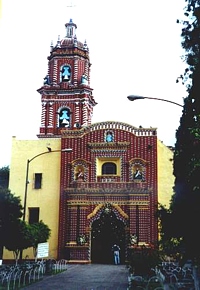
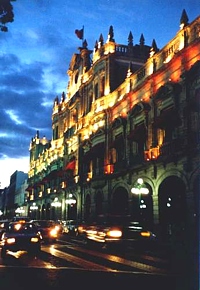 Tonantzintla, a masterpiece
of Mexican baroque. We had an early dinner at VIPS in Puebla and visited
the artisan market El Parian. The evening was finished off with a drink
at the bar of the Hotel Royalty on the Zócalo (main square).
Tonantzintla, a masterpiece
of Mexican baroque. We had an early dinner at VIPS in Puebla and visited
the artisan market El Parian. The evening was finished off with a drink
at the bar of the Hotel Royalty on the Zócalo (main square).
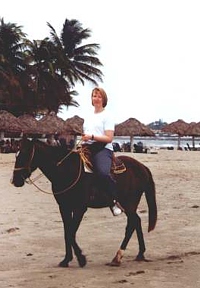
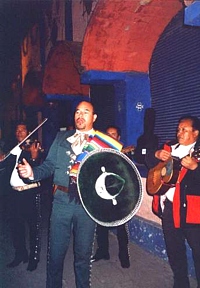 the one bed (the room we had before was
really large and had two double beds) and it didn't have any windows. Well,
I guess you can't have everything... In the evening we were invited for
a three-course dinner by Aida's sister and brother-in-law. They had also
hired a mariachi band who played just for us, it was great!
the one bed (the room we had before was
really large and had two double beds) and it didn't have any windows. Well,
I guess you can't have everything... In the evening we were invited for
a three-course dinner by Aida's sister and brother-in-law. They had also
hired a mariachi band who played just for us, it was great!
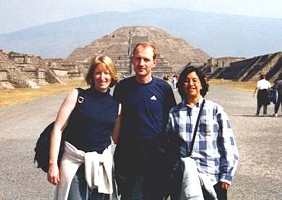 6th century. It was a city the size of ancient Athens
and Rome. It thrived as the primary center of learning and culture in America
for over one thousand years, before it was abandoned about
6th century. It was a city the size of ancient Athens
and Rome. It thrived as the primary center of learning and culture in America
for over one thousand years, before it was abandoned about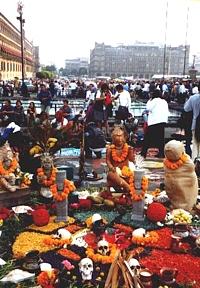 fifteen-hundred
years ago, nobody knows why. We walked the Avenue of the Dead and climbed
both the impressive, 70m high Pyramid of the Sun and the not much smaller
Pyramid of the Moon. We had lunch at one of the tourist eateries surrounding
the archeological site. Then we returned to Mexico City and visited the
Zócalo, the Cathedral and the Templo Mayor. The historic center
of Mexico City is the Plaza de la Constitución, more commonly known
as the Zócalo, the world's largest
square. The Zócalo and the Catedral Metropolitana were built with
stones from the ruins of the temples and palaces of the Aztec city of Tenochtitlán.
The Spanish crown, led by Hernan Cortés, conquered the Aztec Empire
in 1521. Tenochtitlán was built on a one-square-mile island in the
middle of an enormous shallow lake, so many of Mexico City's older buildings
and churches are sinking into the boggy ground on which they were constructed.
The cathedral is probably the largest on the American continent, but it
has been badly damaged by earthquakes. To prevent further damage its interior
is iron-clad. Just east of the cathedral are the remnants of the Templo
Mayor, the Aztecs' principal temple, and the museum that houses the artifacts
discovered at the site, which we also visited (35 pesos). We got a good
view of the Zócalo from the roof-top terrace of the Hotel Majestic.
The usually empty square was crowded with people celebrating the Day of
the Dead (Día de los Muertos). There were many altars decorated
for the dead who were said to visit that day. Indians were dancing and
there were two stages for concerts. It was really a spectacle. For dinner
we went to the American chain restaurant Tony Roma's in the World Trade
Center of Mexico City.
fifteen-hundred
years ago, nobody knows why. We walked the Avenue of the Dead and climbed
both the impressive, 70m high Pyramid of the Sun and the not much smaller
Pyramid of the Moon. We had lunch at one of the tourist eateries surrounding
the archeological site. Then we returned to Mexico City and visited the
Zócalo, the Cathedral and the Templo Mayor. The historic center
of Mexico City is the Plaza de la Constitución, more commonly known
as the Zócalo, the world's largest
square. The Zócalo and the Catedral Metropolitana were built with
stones from the ruins of the temples and palaces of the Aztec city of Tenochtitlán.
The Spanish crown, led by Hernan Cortés, conquered the Aztec Empire
in 1521. Tenochtitlán was built on a one-square-mile island in the
middle of an enormous shallow lake, so many of Mexico City's older buildings
and churches are sinking into the boggy ground on which they were constructed.
The cathedral is probably the largest on the American continent, but it
has been badly damaged by earthquakes. To prevent further damage its interior
is iron-clad. Just east of the cathedral are the remnants of the Templo
Mayor, the Aztecs' principal temple, and the museum that houses the artifacts
discovered at the site, which we also visited (35 pesos). We got a good
view of the Zócalo from the roof-top terrace of the Hotel Majestic.
The usually empty square was crowded with people celebrating the Day of
the Dead (Día de los Muertos). There were many altars decorated
for the dead who were said to visit that day. Indians were dancing and
there were two stages for concerts. It was really a spectacle. For dinner
we went to the American chain restaurant Tony Roma's in the World Trade
Center of Mexico City.

 At
10 a.m. the next morning the bus picked us up at the hotel. There was no
breakfast at the hotel, and it was hard to find anything open early on
Saturday morning, so we ended up at Woolworth's where we had an American
breakfast. The wedding started at 11 a.m.. The ceremony lasted one hour
and was held in Spanish and French. Those of our group who spoke none of
these languages had to content themselves with watching. After church the
bus took us to Metepec, just outside of Toluca, where the wedding party
took place in a garden. There was a buffet lunch, then traditional dances
were shown and the mariachis played their traditional music. It was I who
caught the bouquet!
For a souvenir all the foreign visitors received an Arból de Vida,
a colorful "tree of life", made from clay and used as a candlestick. After
sunset it grew fairly cold but the fiesta continued inside with music and
dancing until about 9 p.m. As the bus was gone by then, some family members
were so kind to give us a ride back to the hotel.
At
10 a.m. the next morning the bus picked us up at the hotel. There was no
breakfast at the hotel, and it was hard to find anything open early on
Saturday morning, so we ended up at Woolworth's where we had an American
breakfast. The wedding started at 11 a.m.. The ceremony lasted one hour
and was held in Spanish and French. Those of our group who spoke none of
these languages had to content themselves with watching. After church the
bus took us to Metepec, just outside of Toluca, where the wedding party
took place in a garden. There was a buffet lunch, then traditional dances
were shown and the mariachis played their traditional music. It was I who
caught the bouquet!
For a souvenir all the foreign visitors received an Arból de Vida,
a colorful "tree of life", made from clay and used as a candlestick. After
sunset it grew fairly cold but the fiesta continued inside with music and
dancing until about 9 p.m. As the bus was gone by then, some family members
were so kind to give us a ride back to the hotel.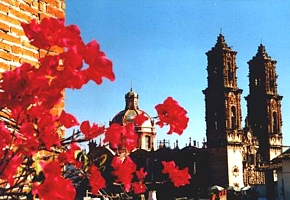 The next morning the
group split up. As arranged the day before, a taxi arrived at the hotel
at 9 a.m. to take us to the Terminal de Autobuses Sur (TAS) bus station
in Mexico
City. We shared the 350 pesos with Myriam and Christian who accompanied
us.
The next morning the
group split up. As arranged the day before, a taxi arrived at the hotel
at 9 a.m. to take us to the Terminal de Autobuses Sur (TAS) bus station
in Mexico
City. We shared the 350 pesos with Myriam and Christian who accompanied
us. 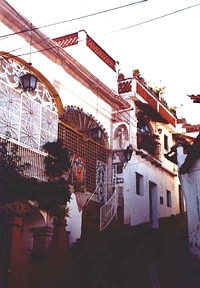 This time we needed only one hour to get back to Mexico City. While
Myriam and Christian took a direct bus to Acapulco, Volker and I caught
a (first class) bus (
This time we needed only one hour to get back to Mexico City. While
Myriam and Christian took a direct bus to Acapulco, Volker and I caught
a (first class) bus (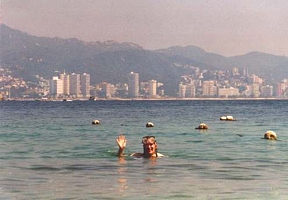 Acapulco after a 4-hours drive
without further problems. We took a taxi (35 pesos after some bargaining)
to our
Acapulco after a 4-hours drive
without further problems. We took a taxi (35 pesos after some bargaining)
to our
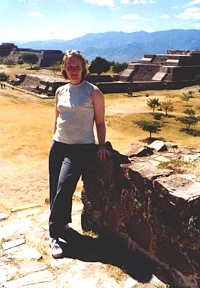 We
were to be picked up by a minibus at 10 a.m. on Friday morning. The group
consisted of two young women from Switzerland and an American couple as
well as some Mexicans. The Monte Albán pyramids are perched on a
flattened mountain top with a superb view of the Oaxaca valley. Over the
centuries the site was inhabited by the Olmec, Zapotec and Mixtec cultures,
and also influenced by the Chiapas and the Maya, as well as Teotihuacán.
The tour lasted 3 1/2 hours, then we were dropped off at the Zócalo
from where we started our self-guided
visit of downtown
We
were to be picked up by a minibus at 10 a.m. on Friday morning. The group
consisted of two young women from Switzerland and an American couple as
well as some Mexicans. The Monte Albán pyramids are perched on a
flattened mountain top with a superb view of the Oaxaca valley. Over the
centuries the site was inhabited by the Olmec, Zapotec and Mixtec cultures,
and also influenced by the Chiapas and the Maya, as well as Teotihuacán.
The tour lasted 3 1/2 hours, then we were dropped off at the Zócalo
from where we started our self-guided
visit of downtown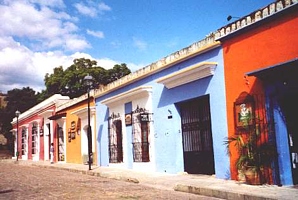 Oaxaca. From all the places we saw during our Mexico
trip we liked Oaxaca best. Part of the town center is pedestrianized which
serves as a welcome break from the usual noise and hectic of the traffic.
We stopped by the bus station to purchase tickets for our return trip to
Puebla the following day (183 pesos,
Oaxaca. From all the places we saw during our Mexico
trip we liked Oaxaca best. Part of the town center is pedestrianized which
serves as a welcome break from the usual noise and hectic of the traffic.
We stopped by the bus station to purchase tickets for our return trip to
Puebla the following day (183 pesos,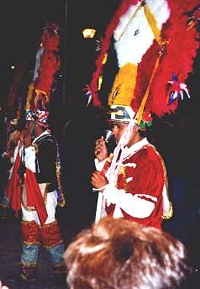
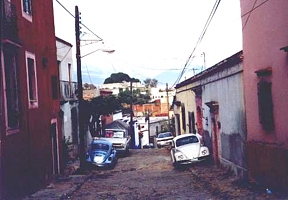 During
our last day in Oaxaca we met Claudia and Kai who were staying at the same
hotel, so at breakfast we ran into each other! We went to the Zócalo
together where I bought some necklaces for a souvenir. I found it wasn't
so easy to bargain for the necklaces, besides they already were quite cheap
and the local people have to make their living that way, so I think one
shouldn't bargain too much. Nevertheless I'm sure we did pay a tourist
price. Soon it was time to take a taxi (30 pesos) to the bus station to
catch our bus to Puebla at 1.30 p.m. During the 5-hour trip we stopped
once in Tehuacán. At the bus station in
During
our last day in Oaxaca we met Claudia and Kai who were staying at the same
hotel, so at breakfast we ran into each other! We went to the Zócalo
together where I bought some necklaces for a souvenir. I found it wasn't
so easy to bargain for the necklaces, besides they already were quite cheap
and the local people have to make their living that way, so I think one
shouldn't bargain too much. Nevertheless I'm sure we did pay a tourist
price. Soon it was time to take a taxi (30 pesos) to the bus station to
catch our bus to Puebla at 1.30 p.m. During the 5-hour trip we stopped
once in Tehuacán. At the bus station in 